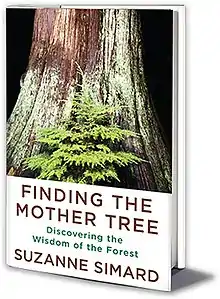Finding the Mother Tree
Finding the Mother Tree is a memoir by the Canadian forest ecologist Suzanne Simard. It has been reviewed in The New York Times,[1] The Guardian,[2] The Washington Post,[3] The Wall Street Journal,[4] among other publications.[5]
 First edition (US) | |
| Author | Suzanne Simard |
|---|---|
| Audio read by | Suzanne Simard |
| Cover artist | Photo: Paul Colangelo, jacket design: Kelly Blair |
| Country | United States |
| Language | English |
| Subject |
|
| Published | 2021
|
| Media type |
|
| Pages | 337 |
| ISBN | 978-0525656098 hardcover |
| Website | suzannesimard |
In her memoir, Simard asserts that trees in forests are interdependent with fungi mycelium. Trees and other plants exchange sugars through their respective root and mycelial structures to share and trade micronutrients. Simard presents her research that fungi physically and chemically connect with the root systems of multiple trees, across species, to create micronutrient pipelines of exchange within a forest community to share these nutrients as well as other molecules. This challenges the "prevailing theory that cooperation is of lesser importance than competition in evolution and ecology."[4]
Simard asserts that healthy forests center on a matriarch tree that acts as a nexus of nutrient distribution that shares these nutrients among other trees of the same or different ages and species that are chemically and physically linked together by an expansive mycorrhizal network.[1] These large-scale, old "mother trees" serve as hubs within the forest network, to deliver carbon to young seedlings through their roots underground in cooperation with fungi.[6]
Simard faced ridicule and gendered attacks by male colleagues during her younger years; however her research became "critical to addressing problems in the timber industry" that led to reforms in sustainable forestry.[4][1]
Critical reception
The Guardian compared the book to Robert Macfarlane's book Underland, and Peter Wohlleben's The Hidden Life of Trees.[2]
The Wall Street Journal named Finding the Mother Tree one of the ten best books of the year; The Washington Post and Time magazine named it one of the best books of the year.[7]
Jonathan Slaght wrote in a review in the New York Times, "This book is a testament to Simard's skill as a science communicator...her arguments are buoyed by rigorous, decades-spanning research".[1]
Scientific reception
In a paper published in Trends in Plant Science, numerous botanical researchers criticized the claims made in the book, some of which are not based on scientific data and contradict established knowledge in many respects, in order to promote a misleading anthropomorphization of trees.[8]
References
- Slaught, Jonathan C. (May 3, 2021). "The Woman Who Looked at a Forest and Saw a Community". The New York Times. Retrieved January 7, 2022.
- Francis-Baker, Tiffany (May 8, 2021). "Finding the Mother Tree by Suzanne Simard review – a journey of passion and introspection". The Guardian. Retrieved January 7, 2022.
- Brown, Kate (May 21, 2021). "A scientist's career in communion with trees". The Washington Post. Retrieved January 7, 2022.
- Bone, Eugenia (May 7, 2021). "Bookshelf 'Finding the Mother Tree' Review: Seeing the Forest". The Wall Street Journal. Retrieved January 7, 2022.
- "Suzanne Simard's New Book Earns International Acclaim | UBC". May 20, 2021.
- Popkin, Gabriel (November 2022). "Are Trees Talking Underground? For Scientists, It's in Dispute". The New York Times. Retrieved November 9, 2022.
- Finding the Mother Tree. Penguin/Random House. Retrieved January 7, 2022.
- Robinson, David G.; Ammer, Christian; Polle, Andrea; Bauhus, Jürgen; Aloni, Roni; Annighöfer, Peter; Baskin, Tobias I.; Blatt, Michael R.; Bolte, Andreas; Bugmann, Harald; Cohen, Jerry D.; Davies, Peter J.; Draguhn, Andreas; Hartmann, Henrik; Hasenauer, Hubert (September 19, 2023). "Mother trees, altruistic fungi, and the perils of plant personification". Trends in Plant Science. doi:10.1016/j.tplants.2023.08.010. ISSN 1360-1385.